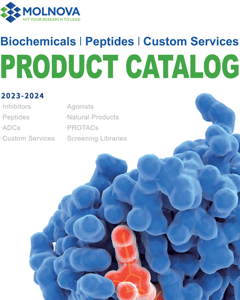
Osteogenic Growth Peptide, OGP
CAS No. 132996-61-3
Osteogenic Growth Peptide, OGP( —— )
Catalog No. M30518 CAS No. 132996-61-3
Osteogenic Growth Peptide, OGP is a short, naturally occurring 14-mer growth factor peptide found in serum at μM concentrations. Osteogenic growth peptide OGP is a key factor in the mechanism of the systemic osteogenic response to local bone marrow injury.
Purity : >98% (HPLC)
 COA
COA
 Datasheet
Datasheet
 HNMR
HNMR
 HPLC
HPLC
 MSDS
MSDS
 Handing Instructions
Handing Instructions
| Size | Price / USD | Stock | Quantity |
| 5MG | 356 | Get Quote |


|
| 10MG | 579 | Get Quote |


|
| 100MG | Get Quote | Get Quote |


|
| 200MG | Get Quote | Get Quote |


|
| 500MG | Get Quote | Get Quote |


|
Biological Information
-
Product NameOsteogenic Growth Peptide, OGP
-
NoteResearch use only, not for human use.
-
Brief DescriptionOsteogenic Growth Peptide, OGP is a short, naturally occurring 14-mer growth factor peptide found in serum at μM concentrations. Osteogenic growth peptide OGP is a key factor in the mechanism of the systemic osteogenic response to local bone marrow injury.
-
DescriptionOsteogenic Growth Peptide, OGP is a short, naturally occurring 14-mer growth factor peptide found in serum at μM concentrations. Osteogenic growth peptide OGP is a key factor in the mechanism of the systemic osteogenic response to local bone marrow injury.(In Vitro):Osteogenic Growth Peptide (OGP) regulates proliferation, differentiation, and matrix mineralization in osteoblast lineage cells. The active portion of OGP, the OGP(10-14) region, is cleaved from the peptide and binds to the OGP receptor which activates the MAP kinase, the Src, and the RhoA pathways. Osteogenic Growth Peptide (OGP) is a native molecule with a primary structure identical to the C-terminus of histone H4, whose sequence contains a highly conserved 14-amino acid motif (NH2-ALKRQGRTLYGFGG-OH). This peptide is isolated from blood during osteogenic remodeling of post-ablation of marrow regeneration. The osteogenic growth peptide (OGP) and its C-terminal pentapeptide OGP(10-14) have been shown to stimulate the proliferation, differentiation, alkaline phosphatase activity and matrix mineralization of osteoblastic lineage cells.
-
In VitroOsteogenic Growth Peptide (OGP) regulates proliferation, differentiation, and matrix mineralization in osteoblast lineage cells. The active portion of OGP, the OGP(10-14) region, is cleaved from the peptide and binds to the OGP receptor which activates the MAP kinase, the Src, and the RhoA pathways. Osteogenic Growth Peptide (OGP) is a native molecule with a primary structure identical to the C-terminus of histone H4, whose sequence contains a highly conserved 14-amino acid motif (NH2-ALKRQGRTLYGFGG-OH). This peptide is isolated from blood during osteogenic remodeling of post-ablation of marrow regeneration. The osteogenic growth peptide (OGP) and its C-terminal pentapeptide OGP(10-14) have been shown to stimulate the proliferation, differentiation, alkaline phosphatase activity and matrix mineralization of osteoblastic lineage cells.
-
In Vivo——
-
Synonyms——
-
PathwayOthers
-
TargetOther Targets
-
Recptor——
-
Research Area——
-
Indication——
Chemical Information
-
CAS Number132996-61-3
-
Formula Weight1523.74
-
Molecular FormulaC68H110N22O18
-
Purity>98% (HPLC)
-
SolubilityIn Vitro:?H2O : 100 mg/mL (65.63 mM)
-
SMILES——
-
Chemical NameSequence:Ala-Leu-Lys-Arg-Gln-Gly-Arg-Thr-Leu-Tyr-Gly-Phe-Gly-Gly
Shipping & Storage Information
-
Storage(-20℃)
-
ShippingWith Ice Pack
-
Stability≥ 2 years
Reference
Moore NM, et al. The use of immobilized osteogenic growth peptide on gradient substrates synthesized via clickchemistry to enhance MC3T3-E1 osteoblast proliferation. Biomaterials. 2010 Mar;31(7):1604-11.
molnova catalog



related products
-
Cy5.5
Cy5.5 is a near-infrared fluorescent dye for labeling biomolecules such as peptides, proteins and oligonucleotides (Ex=673 nm, Em=707 nm).
-
Allitol
Allitol is a substrate for the production of L-form ketoses and aldoses.
-
Thonzylamine hydroch...
Thonzylamine hydrochloride is an anticholinergic and antihistamine used as an antipruritic.



 Cart
Cart
 sales@molnova.com
sales@molnova.com


